Restoring something to its original state can be a daunting task. Just ask Tom Blanchard and other UT Martin faculty members and students.
For Blanchard, UTM biological sciences professor, restoration projects can benefit land, streams, wildlife and people. His work with the West Tennessee River Basin Authority (WTRBA) at DeLoach Creek in northern Madison County aims to restore fallow fields to their natural state, re-establish some of the floodplain function and provide a natural habitat for future visitors.
Middle Fork Bottoms State Park, one of Tennessee’s newest state parks, sits on the north side of Forked Deer River near the town of Three Way. DeLoach Creek is located on the south side of the river, where 300 acres of former agricultural land are prone to flooding. The state purchased the land, and the WTRBA aims to restore the stream’s natural path and reconnect the floodplain.
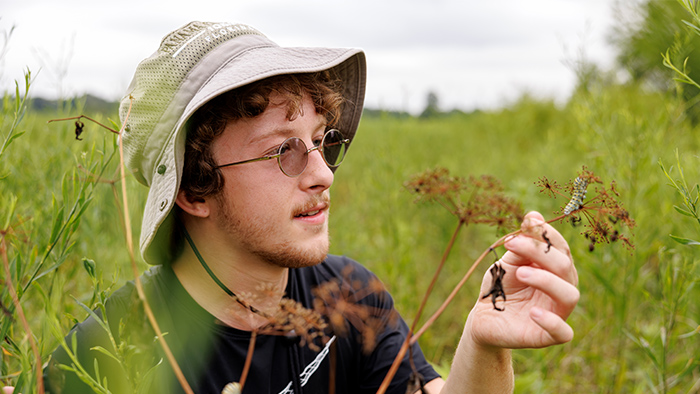
Kayla Key (Martin ’12), who now works with the WTRBA, asked the university for additional assistance.
“Dr. Blanchard’s past research with WTRBA on fish responses to stream restoration prompted me to approach him with an opportunity to expand that type of research to other taxa groups,” she says. “Having been an undergraduate at UTM, I was aware of the excitement and expertise the UTM biology faculty have around research on native species in this area and their passion for undergraduate involvement.”
Biological restoration has an important place alongside stream restoration. What benefits DeLoach Creek should benefit Middle Fork Bottoms State Park just across the river.
“There are people that like to see things, that like to see a nighthawk or like to see a spotted salamander or like to see a black racer—just wildlife viewing,” says Blanchard. “When I go out, I like to see those things, and there’s lots of other people that do that, too, and so bringing back native wildlife is important.”
Previewing Change
Blanchard organized an early August visit to the DeLoach Creek site. Two all-terrain vehicles traveled through heavy vegetation on the former cropland to where the creek meets the Middle Fork of the Forked Deer River. The creek’s depth varies from waist-deep water to shallow pools and was low enough this day to allow a short trek up the channel.
Kris Gordon (Martin ’10) works with the WTRBA, which is tasked with maintaining the flow and function of West Tennessee streams.
“We’re looking at taking DeLoach Creek and meandering it, increasing its length, adding some flood benefits and hopefully some wetland benefits on this property that used to be all row crop,” Gordon explains. “It’s been out of row crop for several years, and we’re just hoping to restore some of its flood function as well as increase floodplain for when the rivers get up. It’ll help take some of that flood peak off.”
Returning the stream to its original state is an engineering task, and duplicating what was in place decades ago won’t be perfect, but the changes made will matter.
“It’s kind of hard to find old maps where the old meanders are,” Gordon says. “But that is our intent—to get it back to a meandered stream, instead of being straight, to mimic natural flow.”
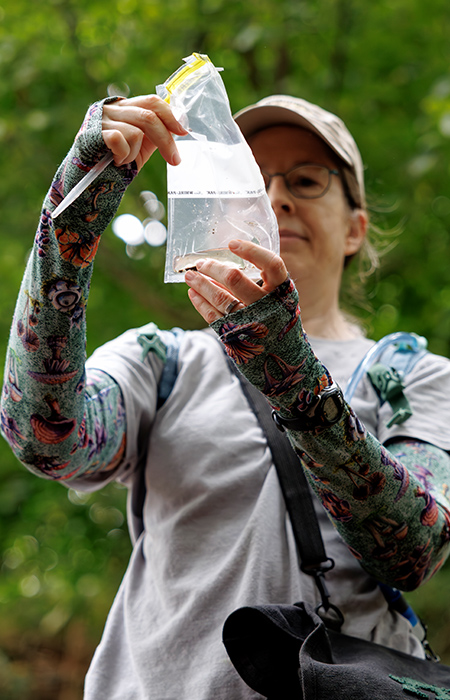
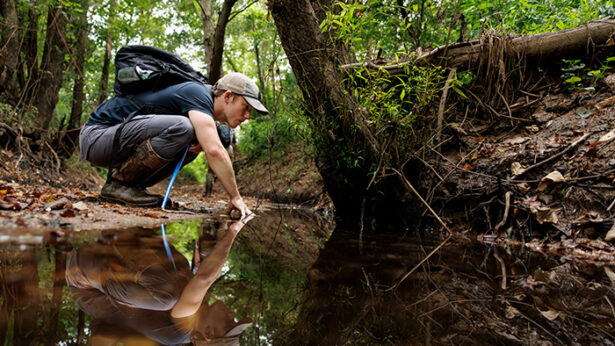
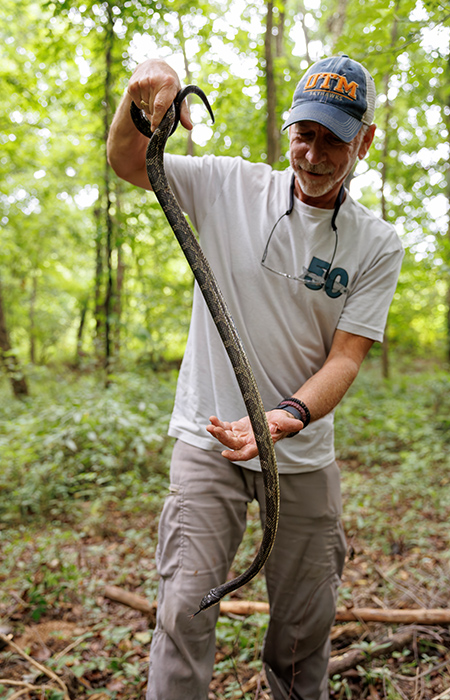
Click to Expand Images
UT Martin senior Noah Hickman of Cedar Grove helps Blanchard locate and sample reptiles and amphibians to determine the site’s diversity. He’s also working with faculty member Lisa Krueger to study plant composition, while senior student Mickey Rodriguez of Trenton assists faculty members with project work while he conducts a personal research project comparing upstream and downstream water quality.
“I want to get into this line of work whenever I graduate,” says Rodriguez, who also is a WTRBA intern. “I really have a preference for habitat management, especially in aquatic or wetland habitats.”
“It’s a beautiful site, and it’s a great start to a career,” Hickman adds. “It’s highly motivating to want to do more work like this.”
Melody Sain (Martin ’12) works as an environmental consultant with WTRBA. Sain, a botanist, will propagate plants, possibly including river cane, in the restored site. She also will help introduce mussels with their natural filtering ability and fish at this site.
“I kind of like thinking of it as self-sustaining wetlands where you have mussels, you have fish, you have plants that are cleaning your water, filtering and helping out (with water quality),” she says.
Drew Barclay graduates in December with a degree in organismal biology and had been deciding his next steps when Blanchard told him of a new partner position with the Tennessee Wildlife Resources Agency and WTRBA. Currently a WTRBA intern, Barkley transitioned into the new partner position this fall and works with mussel propagation and introduces the mollusks to rivers to improve water quality.
Although DeLoach Creek is too shallow to support a mussel population, Barclay sees a bigger opportunity just beyond the creek bank.

“The Forked Deer River would be great for mussel relocation. … I’m sure it’s real healthy as it is, but the more mussels we can get out in the environment and get them working for a long period of time and growing and filtering the water, the better,” Barkley says.
Jennifer Greenwood, UTM biological sciences professor, has worked with the restoration project from its beginning. She determines how stream restoration changes the diatom community, which she expects to thrive with channelization reduction.
Diatoms are a type of aquatic microscopic algae that have glass cell walls and are colorful to view under a microscope. They are an important food source for fish and other animals, as well as providing oxygen.
“Right now, there’s a lot of sediment in the stream that’s very shifty, and so every time it rains pretty hard, it’s going to move that around, and it makes it hard for the diatoms to grow,” she says. “If we also get more stuff—we’d call it biomass—just more growth, that would probably mean that the flow is a little more stable, and so we could get more growth of diatoms.”
Stream restoration is a complex task that requires many kinds of expertise. During a final stop while exiting the site, Blanchard’s herpetology skills came into play when he caught a 4-foot rat snake that remained calm through the experience.
“Rat snakes, as well as other large snake species like king snakes, copperheads and rattlesnakes, feed heavily on rodents such as mice and squirrels,” Blanchard says. “The presence of these species helps to control populations of rodents and may also have a significant impact on tick populations by controlling the abundance of their hosts.”
Things to Know About Rat Snakes
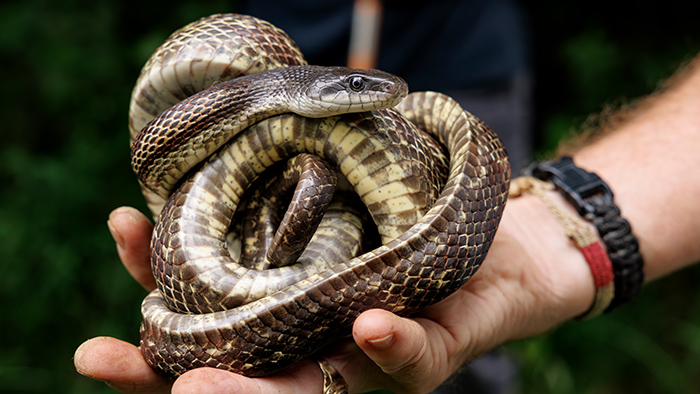
Tom Blanchard has seen and caught a snake or two on his way to earning a Ph.D. from Louisiana State University. His academic specialties include herpetology and ichthyology.
“Most snakes, including rat snakes, are forest-dwelling animals,” he says. “We hope that the restoration of the DeLoach Creek system to a typical bottomland hardwood forest will allow the recolonization of this area by rat snakes and other species of plants and animals normally found in this type habitat.”
- The gray rat snake (Pantherophis spiloides) is nonvenomous and one of 32 snake species native to Tennessee.
- Adult gray rat snakes can grow to 6 feet in length.
- As the name implies, gray rat snakes feed heavily on rodents, but they also frequently consume birds and bird eggs.
- Gray rat snakes are excellent climbers and often found in trees, barn rafters (where mice are plentiful) or occasionally in the attic of a home.
- In some parts of Tennessee, they are commonly referred to as chicken snakes because they are found near and in chicken coups where they feed on young chicks and chicken eggs.
- The gray rat snake is an egg-laying species, and females typically deposit 12 to 18 eggs in decaying logs, rotting tree trunks or debris piles on the forest floor where conditions are moist and relatively warm.
- Females do not guard their eggs or care for hatchlings.



